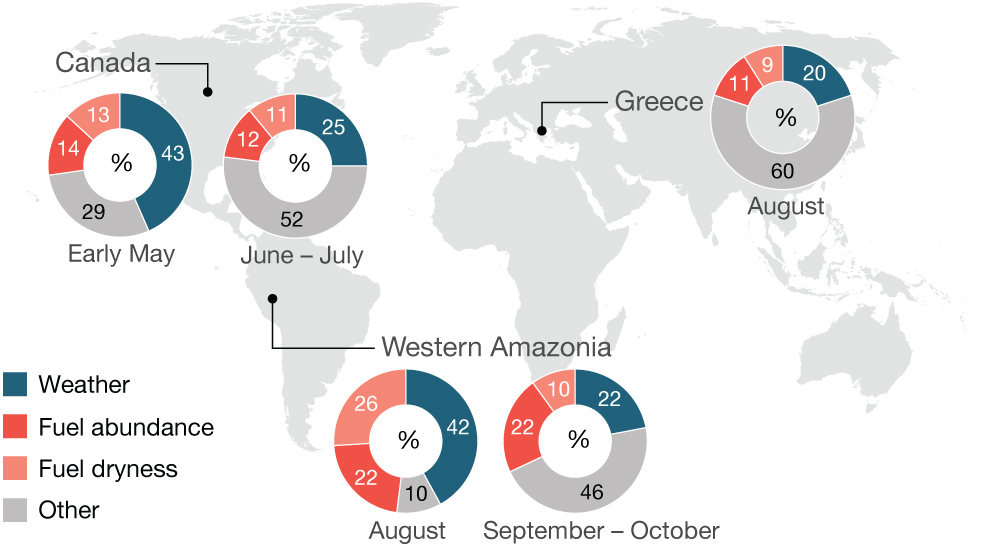The State of Wildfires report (https://essd.copernicus.org/articles/16/3601/2024/), the first edition of a new systematic annual review of wildfires across the globe, was published in the journal Earth System Science Data (ESSD) in August. The publication takes stock of extreme wildfires of the 2023–2024 season, explains their causes, and assesses whether events could have been predicted. It also evaluates how the risk of similar events will change in future under different climate change scenarios.
The report, which will be published annually, is co‑led by authors from ECMWF, the UK Met Office, the University of East Anglia (UK), and the UK Centre for Ecology & Hydrology, with the support of more than 40 fire scientists from five continents.
Main outcomes of this year’s report
Globally, during the March 2023 to February 2024 fire season, wildfires released 2.4 Gt of carbon (C), or 8.8 Gt of carbon dioxide (CO2), into the atmosphere – an amount equivalent to the combined annual anthropogenic emissions of the USA, the EU, and South America.
Notable fire events included a record-breaking fire season in Canada, the largest recorded wildfire in the EU (Greece), El Niño-driven drought fires in western Amazonia and northern South America, and deadly, fast-moving fires in Hawaii and Chile. All major wildfires combined claimed over 250 lives and led to the evacuation of at least 250,000 people worldwide.
The report highlights how human-driven climate changes have made these extreme fire events more likely. An attribution analysis led by the UK Met Office shows how human influence has made fire weather conditions witnessed during parts of the 2023–2024 fire season three times more likely in Canada, 20 times more likely in western Amazonia, and twice as likely in Greece.
The report also explores the likely scenarios if human emissions continue at their current pace or decrease thanks to reduction efforts. Even assuming emission reduction initiatives are in place, a Canadian born today is more likely than not to experience another fire season of similar magnitude to last year’s within their lifetime. In comparison, someone born in the 1940s would have had a one‑in‑ten chance of witnessing such an event.
ECMWF’s contribution
ECMWF contributed to diagnosing the drivers of wildfires, assessing their predictability, and evaluating emissions related to these events.
The Centre's fire weather forecast identified which events could be predicted and at what lead time, proving forecasting skills at the seasonal timescale.
The Probability of Fire (PoF) model used by ECMWF provided valuable insights into the drivers of key wildfire events (see the figure). The model concluded that early-season wildfires in Canada and Western Amazonia were primarily driven by extreme fire weather conditions. However, persistent wildfires later in the season were unlikely to have been caused by anomalous weather or fuel conditions alone. This suggests that several factors unaccounted for by the model may have contributed to the prolonged fire season. These factors may include limited fire management resources following the unprecedented early season activity, continued fire spread not captured by the model, land management practices, or the re‑emergence of dormant early-season fires.

Data from the EU's Copernicus Atmosphere Monitoring Service (CAMS), which is implemented by ECMWF, was also used extensively in the report. The reported fire emission totals were based on the mean value between CAMS Global Fire Assimilation System (GFAS) and Global Fire Emissions Database (GFED) datasets. Additional context for the impact of fire emissions on air quality was provided with the CAMS reanalysis of global atmospheric composition, showing that Canada had the highest annual average surface concentrations of particulate matter less than 2.5 micrometres in diameter (PM2.5) in 2023. Meanwhile, many regions of North America experienced concentrations above the US Environmental Protection Agency’s exposure threshold of 35 μg/m3 for more than 10 days, increasing to more than 120 days close to the where the fires were burning in western Canada.
Media impact
Officially published on Wednesday, 14 August 2024, the report attracted significant media attention, being featured in over 600 items of international coverage. It has been promptly accepted as a scientific reference source and as a basis for several Wikipedia page updates documenting the extreme wildfires of the 2023–2024 season. It now ranks as ESSD’s 6th most impactful publication, according to Altmetric. The Altmetric score even surpassed those of other major reports, like the Global Carbon Budget and the ‘Indicators of Global Climate Change’, a keystone publication by Intergovernmental Panel on Climate Change (IPCC) Working Group I authors. These achievements are even more impressive given this was the inaugural edition of the report, and we are still in the process of establishing its reputation.
